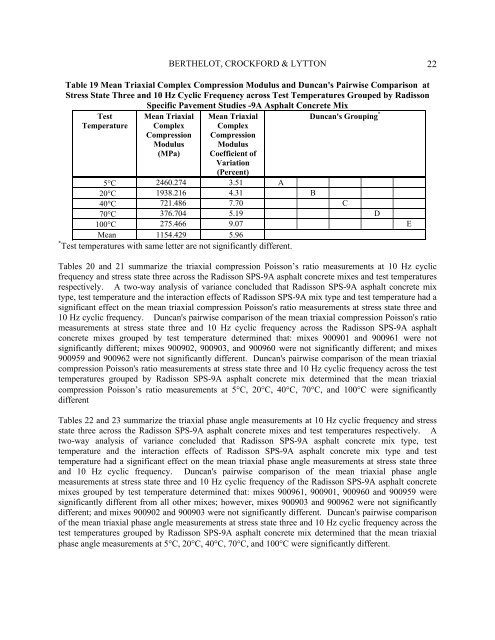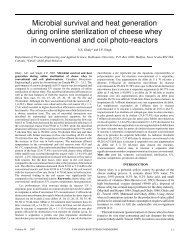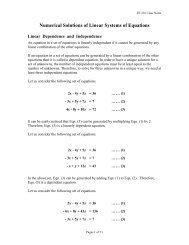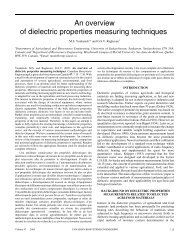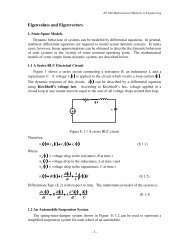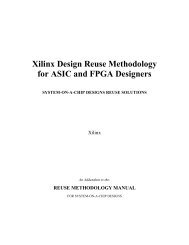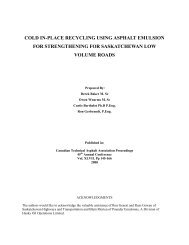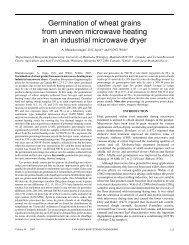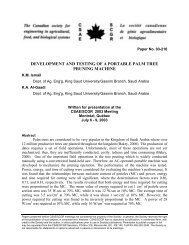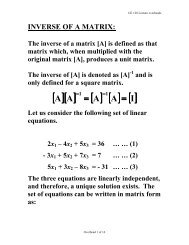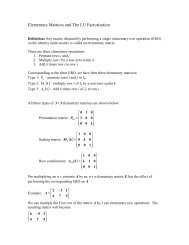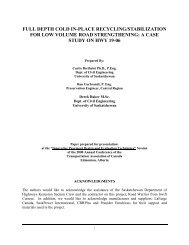comparison of alternative asphalt concrete rut characterization
comparison of alternative asphalt concrete rut characterization
comparison of alternative asphalt concrete rut characterization
You also want an ePaper? Increase the reach of your titles
YUMPU automatically turns print PDFs into web optimized ePapers that Google loves.
BERTHELOT, CROCKFORD & LYTTON 22Table 19 Mean Triaxial Complex Compression Modulus and Duncan's Pairwise Comparison atStress State Three and 10 Hz Cyclic Frequency across Test Temperatures Grouped by RadissonSpecific Pavement Studies -9A Asphalt Concrete MixTestTemperatureMean TriaxialComplexCompressionModulus(MPa)Mean TriaxialComplexCompressionModulusCoefficient <strong>of</strong>Variation(Percent)Duncan's Grouping *5°C 2460.274 3.51 A20°C 1938.216 4.31 B40°C 721.486 7.70 C70°C 376.704 5.19 D100°C 275.466 9.07 EMean 1154.429 5.96* Test temperatures with same letter are not significantly different.Tables 20 and 21 summarize the triaxial compression Poisson’s ratio measurements at 10 Hz cyclicfrequency and stress state three across the Radisson SPS-9A <strong>asphalt</strong> <strong>concrete</strong> mixes and test temperaturesrespectively. A two-way analysis <strong>of</strong> variance concluded that Radisson SPS-9A <strong>asphalt</strong> <strong>concrete</strong> mixtype, test temperature and the interaction effects <strong>of</strong> Radisson SPS-9A mix type and test temperature had asignificant effect on the mean triaxial compression Poisson's ratio measurements at stress state three and10 Hz cyclic frequency. Duncan's pairwise <strong>comparison</strong> <strong>of</strong> the mean triaxial compression Poisson's ratiomeasurements at stress state three and 10 Hz cyclic frequency across the Radisson SPS-9A <strong>asphalt</strong><strong>concrete</strong> mixes grouped by test temperature determined that: mixes 900901 and 900961 were notsignificantly different; mixes 900902, 900903, and 900960 were not significantly different; and mixes900959 and 900962 were not significantly different. Duncan's pairwise <strong>comparison</strong> <strong>of</strong> the mean triaxialcompression Poisson's ratio measurements at stress state three and 10 Hz cyclic frequency across the testtemperatures grouped by Radisson SPS-9A <strong>asphalt</strong> <strong>concrete</strong> mix determined that the mean triaxialcompression Poisson’s ratio measurements at 5°C, 20°C, 40°C, 70°C, and 100°C were significantlydifferentTables 22 and 23 summarize the triaxial phase angle measurements at 10 Hz cyclic frequency and stressstate three across the Radisson SPS-9A <strong>asphalt</strong> <strong>concrete</strong> mixes and test temperatures respectively. Atwo-way analysis <strong>of</strong> variance concluded that Radisson SPS-9A <strong>asphalt</strong> <strong>concrete</strong> mix type, testtemperature and the interaction effects <strong>of</strong> Radisson SPS-9A <strong>asphalt</strong> <strong>concrete</strong> mix type and testtemperature had a significant effect on the mean triaxial phase angle measurements at stress state threeand 10 Hz cyclic frequency. Duncan's pairwise <strong>comparison</strong> <strong>of</strong> the mean triaxial phase anglemeasurements at stress state three and 10 Hz cyclic frequency <strong>of</strong> the Radisson SPS-9A <strong>asphalt</strong> <strong>concrete</strong>mixes grouped by test temperature determined that: mixes 900961, 900901, 900960 and 900959 weresignificantly different from all other mixes; however, mixes 900903 and 900962 were not significantlydifferent; and mixes 900902 and 900903 were not significantly different. Duncan's pairwise <strong>comparison</strong><strong>of</strong> the mean triaxial phase angle measurements at stress state three and 10 Hz cyclic frequency across thetest temperatures grouped by Radisson SPS-9A <strong>asphalt</strong> <strong>concrete</strong> mix determined that the mean triaxialphase angle measurements at 5°C, 20°C, 40°C, 70°C, and 100°C were significantly different.


